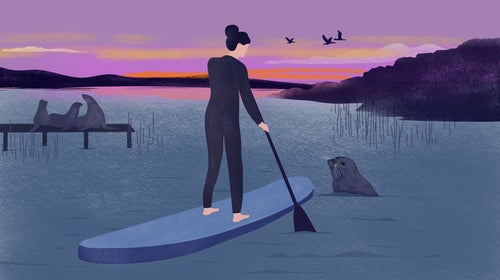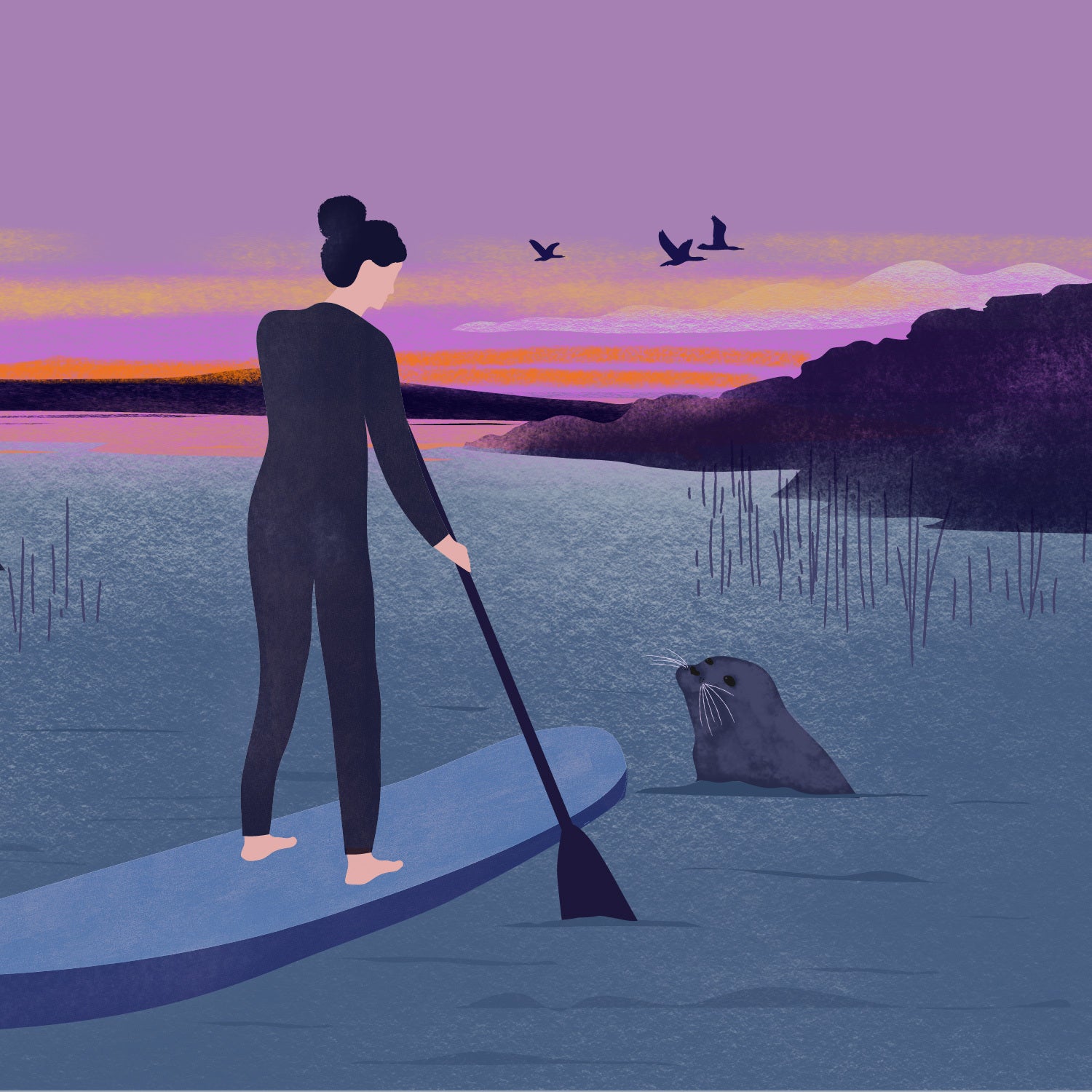It was a summer evening, and I had launched my paddleboard from Henderson Inlet, an arm of Puget Sound only a mile from where I live. I was new to paddling and unsteady on the board, conscious of maintaining my balance with each stroke. Cormorants, who had a nesting site nearby, passed back and forth overhead, calling to each other. And then, behind me, a deep inhale echoed off the water’s surface. I dropped to my knees and looked backward to see a black, perfectly round head with wide eyes. This seal held my gaze for a long moment before disappearing underwater in one sleek swoop. Once he was gone, I felt tethered to him. I wondered if he was close, swimming just below me, or already thousands of feet away.
Seals often introduce themselves this way: I can hear their breath before I see them. In those moments of surfacing, we coexist as mammals, as fellow air breathers. While I belong to the land and they belong to the deep, we meet at the surface, share oxygen, and regard each other with a blend of curiosity and admiration.
I began paddleboarding in August 2020. Like everyone else, I needed some kind of escape. That year was marked for me by a deep and churning loneliness—not only because of pandemic isolation, but also because of the realities of middle age. Over the course of ten years of raising children while working full-time, I’d lost track of myself. I’d allowed my friendships to dissolve until they were practically nothing. I’d become accustomed to walking through the world in zombie mode: wake up, pack lunches, drive to school, go to work, come home, do dishes, start dinner. My partner, locked into her own cycle of to-dos, seemed to orbit on a distant periphery. The things I’d always loved—running, writing, baking—helped me make it through my days but brought me no real joy. I felt as if I barely existed outside my routines of working and caregiving. It took the pandemic lockdown to shake me out of it, unsettle me, connect me to my own mortality, and identify that I needed something.
One summer day, on a trail walk along Henderson Inlet, I looked out on the water and saw someone on a bright orange paddleboard. Suddenly, I no longer wanted to be walking on land—I wanted to be gliding on water. I had lived in the Puget Sound region for my entire adult life, but I’d never taken up kayaking, boating, or other watersports. I’d seen the water as a scenic feature of my life, one best viewed from a distance. But now I wanted to be right up against it.
Harbor seals, it turns out, make wonderful ambassadors to people like me—land dwellers newly called to explore the sea. Like us, seals are creatures of both land and water. Unlike us, they are graceful in water, ungainly on land. Underwater, they spin circles and reach great speeds (12 miles per hour) and depths (up to 1,600 feet). Out of water, they’re wonderfully round and ridiculous. They cannot walk, they can only galumph. On shore they do little more than lie around, nurse, bask, and prepare for the next dive.
Comparisons between seals and dogs are unavoidable. Open any seal video on YouTube, and you won’t have to scroll far to find a comment that says only, “Pups of the ocean” or��“Sea doggos!” I think we arrive at this comparison because, though seals are wild, they convey a rare kind of devotion. Like dogs, they greet us with caring eyes. They welcome us to the sea the way our dogs welcome us home.
Without seals as ambassadors, the Salish Sea would be a beautiful but formidable place.��Egg-yolk and moon jellyfish��float just below the surface of the water. Bald eagles circle overhead looking for prey. Hooded mergansers, startled by human presence, waltz across the water before flying off. In the early autumn, schools of anchovies reflect September sunlight in radiant flashes. After November rains, giant logs, evergreen boughs, and tiny wood chips float everywhere; paddling feels like stirring soup. Blue herons, with their slow, wide flap and low squawk, seem somehow disapproving. But seals are interested, curious, sometimes even solicitous.
More than once, I’ve paddled through Budd Inlet—another arm of Puget Sound just beyond my neighborhood—while a sea lion is visiting the area to hunt salmon. Sea lions, like seals, are pinnipeds, but they’re larger and more aggressive. When they hunt they make quite a commotion, diving in huge lumbering arcs, slapping the water with large flippers. Every time I’ve encountered one, a harbor seal has approached and then trailed me for a time until I’ve achieved a safe distance. Perhaps it’s mere coincidence, but the seal’s friendly interference has felt like an act of stewardship, a deed to ensure communal security.
Over the past few years, harbor seals have kept me coming back to the water. I return because I know I will find them there, though I’m never sure where or how. Sometimes I’ll see one from a great distance. Other times, I’ll count more than a dozen of them hunting together while gulls fly overhead awaiting the entrails from their catch. For a while, there was a huge seal with the same tan coloring and wide bloodshot eyes as my old-man dog at home. He often popped up close to me as I turned a certain inlet bend, but then he stopped appearing. I’ll never know if he died or simply moved on. Even in the winter months, I check��the tides and wind charts to choose at least one weekly time to wriggle into my wetsuit, leave my family behind, and paddle in deep quiet, with only the sound of my paddle in water and the occasional surprise of seal breath.
The cross-cultural folklore around seals frequently ties to motherhood and marriage. In Celtic and Norse legends, the is often a seal-woman who is found by a man and claimed as his wife. Her sealskin confiscated from her, hidden or locked away, the selkie is trapped in her human form. She performs the prescribed domestic role of wife and mother, but she longs for her wildness and searches relentlessly for her other skin. In some versions of the tale, she finds it and escapes to her home, the ocean. Occasionally, she’s seen surfacing near shore, checking on the well-being of her children.
In Inuit mythology, , in spite of her parents’ insistence she marry, refuses many offers. One day, she is courted by a handsome stranger who promises many riches. Once they are married, he brings her to live on a secluded island before revealing that he is actually a bird disguised as a man and cannot provide for her. Sedna’s father eventually appears to rescue her, but on the journey home they encounter a deadly storm. To save his own life, he attempts to lighten his load by pushing Sedna overboard. But Sedna wishes to live, and she grips the side of her father’s boat. He cuts off her fingers, one joint at a time. Sedna’s appendages turn into ocean mammals: whales, walruses, and seals. Sedna becomes a spirit who inhabits the ocean floor and presides over these creatures. She has transformed, fully, from wife and daughter to ocean dweller.
These various legends present wild women detached from their wildness, willing to exercise whatever agency they can to reclaim it. I am no selkie, nor am I Sedna. I’m simply a mortal woman who tires of the daily grind. But seals have helped me reconnect to the part of me that is wild and alive. I have become a person who sometimes takes the long route home from work to glimpse the tides, who pines for her board at the sight of glass-smooth water, who wants to be on or in the salt water as many days of the year as possible. I’ve become a person who tracks the alignment of high tide, sunset, and moonrise, paddling through the narrow part of Henderson Inlet to reach the bay where one can watch the moonrise.
On such a journey, there’s a moment when nearly all the light has dwindled and the moon hasn’t yet appeared. The sky is a grayish violet blur. A dog barks in the distance and the sound carries across the water. For a moment, I feel alone and worried. What if I misread my charts and the moon doesn’t rise? What if I’ll need to paddle home without moonlight? Will my headlamp be enough? The seals, lounging on a nearby log boom, begin talking to each other. One of them calls out. Another replies in a voice that sounds like a low, drunken belch. It’s not a sound I’ve ever heard them make in daylight. They go on and on this way, calling and replying, their noises expansive and crude. I laugh to myself, feeling suddenly unalone—grateful to be here now, eavesdropping on this secret language.


